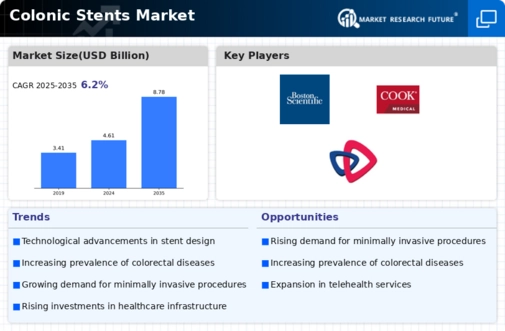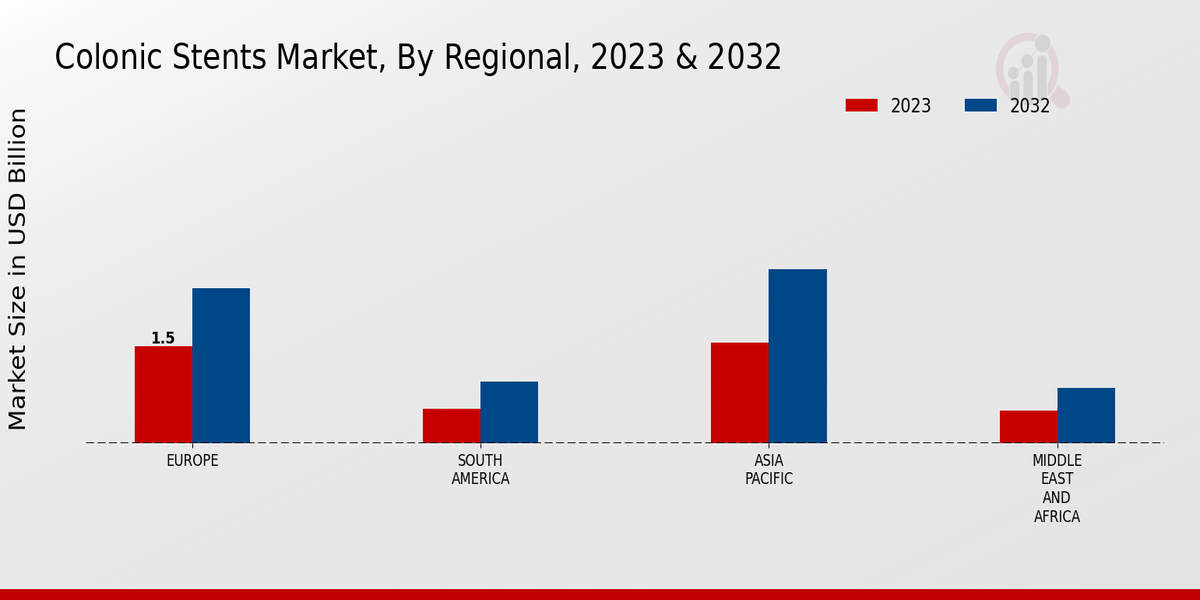Market Growth Projections
The Global Colonic Stents Market Industry is projected to experience substantial growth over the coming years. With a market value of 4.61 USD Billion in 2024, the industry is expected to expand significantly, reaching an estimated 8.78 USD Billion by 2035. This growth trajectory reflects a robust CAGR of 6.03% from 2025 to 2035, indicating a strong demand for colonic stents driven by various factors, including technological advancements, increasing incidence of colorectal cancer, and an aging population. These projections underscore the potential for innovation and investment within the colonic stent sector.
Rising Incidence of Colorectal Cancer
The increasing prevalence of colorectal cancer globally is a primary driver for the Global Colonic Stents Market Industry. As per recent statistics, colorectal cancer ranks as the third most common cancer worldwide, leading to a heightened demand for effective treatment options. Colonic stents serve as a minimally invasive solution for patients with obstructive lesions, thereby facilitating timely interventions. This trend is expected to contribute significantly to the market's growth, with projections indicating a market value of 4.61 USD Billion in 2024. The urgency to address this health crisis underscores the importance of colonic stents in modern medical practice.
Growing Awareness and Screening Programs
Heightened awareness regarding colorectal health and the importance of early detection is propelling the Global Colonic Stents Market Industry. Public health campaigns and screening programs are increasingly encouraging individuals to undergo regular check-ups, leading to earlier diagnoses of colorectal conditions. This proactive approach not only facilitates timely interventions but also drives demand for colonic stents as a treatment option. As awareness continues to grow, healthcare systems are likely to allocate more resources towards screening initiatives, further supporting market expansion. The interplay between awareness and treatment options is crucial for improving patient outcomes in the realm of colorectal health.
Technological Advancements in Stent Design
Innovations in stent technology are reshaping the Global Colonic Stents Market Industry. Recent developments include the introduction of biodegradable stents and advanced materials that enhance biocompatibility and reduce complications. These advancements not only improve patient outcomes but also expand the range of applications for colonic stents. For instance, the use of drug-eluting stents has shown promise in reducing the risk of restenosis. As healthcare providers increasingly adopt these cutting-edge solutions, the market is poised for growth, with an anticipated CAGR of 6.03% from 2025 to 2035, reflecting the industry's commitment to improving patient care.
Regulatory Support and Reimbursement Policies
Supportive regulatory frameworks and favorable reimbursement policies are instrumental in shaping the Global Colonic Stents Market Industry. Governments and health organizations are increasingly recognizing the importance of colonic stents in managing gastrointestinal disorders, leading to streamlined approval processes for new products. Additionally, reimbursement policies that cover the costs associated with stent placement enhance accessibility for patients. This regulatory environment fosters innovation and encourages manufacturers to invest in research and development, ultimately driving market growth. As the industry evolves, the alignment of regulatory support with clinical needs will be vital for sustaining momentum in the colonic stent market.
Aging Population and Increased Healthcare Access
The global demographic shift towards an aging population is a significant factor driving the Global Colonic Stents Market Industry. Older adults are more susceptible to gastrointestinal disorders, including colorectal cancer and bowel obstructions, necessitating the use of colonic stents. Additionally, improved healthcare access in developing regions is likely to increase the diagnosis and treatment of such conditions. This demographic trend is expected to bolster market growth, with estimates suggesting that the market could reach 8.78 USD Billion by 2035. The combination of an aging population and enhanced healthcare infrastructure presents a compelling case for the continued expansion of colonic stent utilization.





